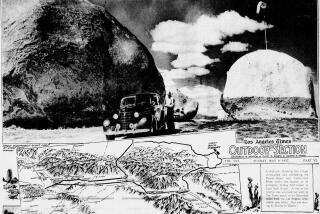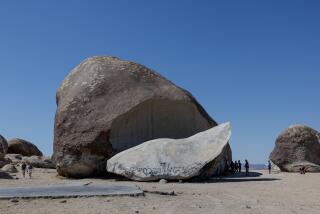To see these Mojave Desert petroglyphs, you first have to pass a Navy screening
The email caught my eye as we drove home from Death Valley months ago: “Fall Petroglyph Tour dates, now available from the Maturango Museum in Ridgecrest!” The promise was a chance to see “the richest known concentration of petroglyphs in the western hemisphere.” OK, sign us up.
But wait, access is strictly limited because the protected petroglyphs are located within the Naval Air Weapons Station at China Lake. There’s an application to fill out and a checklist of required information; better get moving on this.
Fnally, in late October, here we are standing in a high-desert canyon in California’s western Mojave Desert, tucked away on an active military base, staring at ancient images etched into basalt rock walls.
It feels incongruous to find this outdoor cathedral here, with its messages from another time: Were the unknown Paleo-Indian artists beckoning the bighorn sheep in a sort of hunting magic? Were shamans summoning supernatural powers, or perhaps telling stories? Maybe the images are about boundary markers, ethnic identifiers or vision quests? Anthropologists aren’t sure, and the dating of the designs is not agreed on either.
But it’s a magical sight.
The Coso Rock Art National Historic Landmark extends over tens of thousands of mostly off-limits acreage with an estimated tens of thousands of hand-hewn images. During a day of awe, we absorb the sight of some of these designs abraded, pecked or scratched thousands of years ago into the basalt rocks’ “desert varnish” surface.
And the U.S. Navy, stewards of this patch of desert, is tasked with counting and cataloguing each one.
For our group of eight, plus two Navy-approved guide-escorts, the “hike” into Renegade Canyon (or Little Petroglyph Canyon) proceeds at a crawl, as we mostly stop, point, gasp and click (or sketch) every few steps. “Look at that sheep! “ “Did you see this little pattern over here?” “What does that one mean, do you think?”
The images are often abstract — patterns, dots, circles, lines — but also frequently recognizable as the once-abundant big-horn sheep, along with representations of hunters bearing either stylized atlatls (dart or spear thrower) or later, bows and arrows. Plus birds, deer and canines. (There are more recent markings too, probably created since ranching and mining took place in the area beginning in the 1860s, and the Navy began control in the 1940s.)
On this visit, the concern isn’t the usual high-desert temperatures but rain, which will stop a tour. We get a few scattered drops but manage to scramble a good distance down canyon — there are a few steepish drops in the narrow section — viewing the petroglyphs all along the rock walls and (occasionally) on ground-level boulders.
More incongruity: We eat our brown bag lunches near the remnants of a more modern sheep corral with the ancient images all around.
Our day had started at 6:30 am — ready for the military’s inspection with our closed-toe boots, IDs and fueled-up SUVs — and then the 45-mile escorted drive across the base to the 5,000-foot-elevation canyon we are permitted to view. No photos are allowed during transit, sadly, even ones of the lush forest of impressively large Joshua trees near the canyon.
Want to go? Check the Maturango museum website for more information about the remaining tour dates this fall (Nov. 19-20 and Dec. 3-4) and the application process. Cost is $55 for non-museum members. We applied in August for one of three October tour dates; our confirmation came by mail in about 10 days.
Or check with the public affairs office at the Navy’s China Lake base to arrange a private tour. Call (760) 939-1683 or email [email protected].
Also, coming up Nov. 5-6 will be the Ridgecrest Petroglyph Festival, which honors Native American history in the area.
There will be two days of activities centered at nearby Petroglyph Park (which features a short walking trail with replica exhibits), talks on local history, craft booths and more.
During the festival, there are a few short group tours of the canyon, booked in advance.
“The great stone galleries of the Coso Range are windows into the past, windows that reveal far more than can be dug from the ground,” explains researcher Campbell Grant in the book “Rock Drawings of the Coso Range.” (It’s available in the museum gift shop.)
It’s definitely worth a look.
ALSO
Death Valley’s Furnace Creek Resort to receive $50-million makeover, open year-round
Marvel’s Spider-Man, Captain America and Thor will sail with Disney next year
Canada tops Lonely Planet’s list to visit in 2017, see who else made the top ten
A look at the L.A.-themed makeover at LAX’s Terminal 6
More to Read
Sign up for The Wild
We’ll help you find the best places to hike, bike and run, as well as the perfect silent spots for meditation and yoga.
You may occasionally receive promotional content from the Los Angeles Times.






